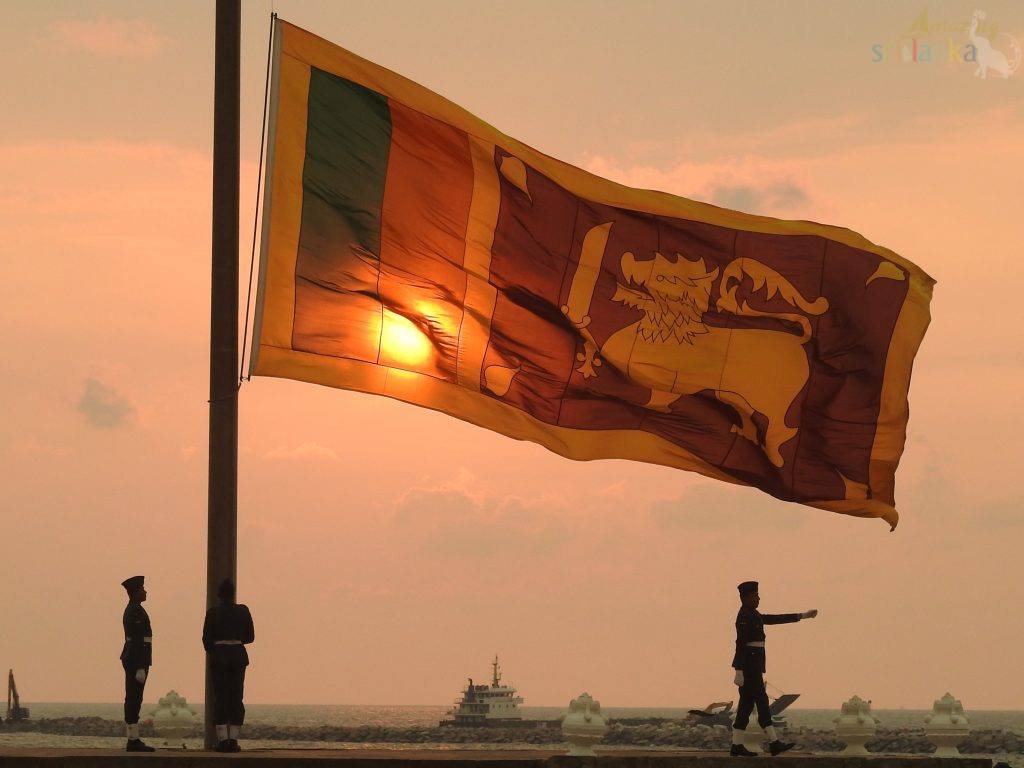Sri Lanka’s National Identity Crisis

A Cultural Anthropological Perspective of the ‘Aragalaya’ at Galleface and elsewhere in Sri Lanka
By Ama H.Vanniarachchy
The public protests that are happening now in Sri Lanka, are an eyeopener in many ways. From a cultural anthropological and sociological perspective, there are so many interesting discussions and observations to make while closely studying these protests. Apart from the suffering and angry public walking out of their homes and expressing their frustration and displease towards the government and politicians, there also can be seen the rise of many other interesting social and cultural trends.
As culture and heritage are not only about lifeless bricks or pillars, culture and heritage are a part of people. It is alive and evolving. It is the people’s consciousness and behavior. Hence we closely observed the protest from its early days to today, to understand the many social and cultural trends that are vibrating and leading it and the social and cultural influence it has on the society and vice versa. We must note that in this brief analysis we did not stick our purview only to Sri Lanka, but also observed the many global cultural and social trends too.
A clash of ideologies and intentions…
Although the protest started off as a protest of the oppressed public against corruption and nepotism, by now there are many other ‘out of track’ slogans and protesters such as requesting for removal of Sinhala communities from the North, hate speech aimed at monks and clergy, certain personalities venting their hatred against iconic Buddhist places such as the temple of the tooth, some carrying slogans sympathizing the late LTTE leader Prabhakaran, etc.
Ageist slogans and racist slogans popped up from here and there at the protest. Another trend that was swept by social media was that there is no such thing as Sinhala Buddhist, while the truth is that technically speaking this is an actual term to identify culture and a community.
Ignorance or purposeful?
Meanwhile, terms such as United Sri Lanka, instead of Unitary Sri Lanka (which is the correct term for the country and also which is in the country’s constitution) were used at the protest. Last week, some covered the eyes of the statue of S.W.R.D.Bandaranayake, which outraged some and was interpreted by many in different ways.
What exactly is happening?
Are they aware of what they are doing?
A few weeks ago, social media was flooded with hashtags requesting Anonymous to save Sri Lanka, which turned out to be a big mockery. People started questioning and doubting the prevailing system and requesting a system change.
What is this system change?
Are we well educated about what we want?
Are we educated about our political history, economic system, geopolitics, and various political, social, and cultural trends?
Can merely learning through Google or social media make us a wise, smart generation?
People feel that the prevailing economic system and the political system have failed the country. But when questioning many, it seems that we need to be more knowledgeable about what we are fighting for and against. This made us highly doubt our education system; are they just buildings that produce batches of students and job-generating institutes (schools and universities) and a waste of public money?
How effective is our public sector?
Are we forcing our beliefs on others?
Hate speech and the ‘cancel culture’ started to dominate social media as people would blindly boycott artists and public figures that do not openly support the protest. The best example is how the same people who loved and embraced Yohani with so much warmth, started canceling her on social media and starting a mud sling campaign.
Are these right? And how fair are they?
People also started arguing with each other and spreading hatred against those who are not outright supporting their ideologies and are of the view that if one does not support their ideology or belief they are definitely supporting the opposing view. Are there only two exact opposite ideologies and beliefs in the world? How fair is it to force others to believe and accept your own ideology? Spreading awareness is different from forcing ideologies; this is not tolerating others.
Not from a political viewpoint, but from a cultural anthropological and sociological viewpoint, these are interesting to study. What is happening behind the stage and what is happening on the stage?
What social and cultural changes the protesters are requesting and trendsetting?
This entire protest starting from Day 1, is an interesting cultural anthropological and sociological study. This helps us understand if we are well equipped with the knowledge, are we a generation and nation that tolerates others, and are we ready to change our consumer economic system to a more productive and sustainable system?
Have we actually obtained positive peace, after ending the bloody 30-year war in 2009?
Let’s find out.
A societal and cultural reform?
Closely studying the protests and the protesters, including their social media campaigns, it is clear that there is an appeal and attempt for a social and cultural change in Sri Lanka, apart from the political and economic change the majority requests. The social and cultural change or reforms the protesters demand is seen to be somewhat clashing with the ideologies that the ones who oppose them believe in.
The truth is that culture and society should be evolving and developing, and as political and economic systems change, society and culture should evolve and change. However, this change must be sustainable and of course, should be fair to all.
Are we going through a National and Cultural Identity Crisis?
Along with the protest, discussions such as nationalism, patriotism, race, and religion came back to the limelight, allowing many to express their views freely. While one group of people firmly believe that these are outdated and baseless ideologies, another group of people strongly believe these are vital and must be cherished.
The article written by Zhou Guanghui and Liu Xiangdong titled National Identity Crisis in Developing Countries in the Global Age published in 2014 in the Social Sciences China (Volume 35, Issue 2) explains that “In terms of the need for social identity, globalization, while changing the power structure of the world, weakens the autonomy of developing countries, especially that of those which are still in the process of modernization and are confronted with risks inherent in social transformation and where a resultant structural imbalance undermines the state’s integrity and control, making national identity less appealing to ethnic groups. As a result, regional ethnic identity comes to the fore, leading to national identity crises in developing countries.”
Major countries and regions are now experiencing a “global crisis of national identity” according to Charles Hill, a former adviser to U.S. secretaries of state George Shultz and Henry Kissinger.
Hill said in a recent interview with The Moscow Times, “And what I see in the massive media blitz being put out from Moscow is an attempt by the Russian government to try to tell the Russian people who they are.”
”You can see the Chinese trying to do something similar with one major media domestic propaganda campaign after another. And in the United States, President Barack Obama is trying to convince the American people that they really have an identity that is starkly different from what the Americans thought their identity was for the last 75 years or more. Europe is probably the worst of all. It’s like an adolescent phase when you are trying to find out who you are when you are 15 years old, and we are seeing this play out all around the world,” he said.
Yes, we too believe our society and culture need sustainable reforms. We are a nation that never revived their national and cultural identity and after independence, we have a set of burrowed systems (economic, political, social, cultural, and religious) that have confused us about our own identity. We are a nation that has no foundation, as our recent political, social and religious leaders failed to do so after gaining independence.
We are going through a cultural and national identity crisis.
The nation we know today as Sri Lankans is only 74 years old and our system (political, economic, and social) is 207 years old which is a system created and continued by the British with the intention of sustaining the British empire during that time. After 1948, instead of refreshing the ‘unrooted’ system, our local politicians continued the entire system, which was a makeup of many systems, borrowed from many parts of the world. For example, our education system was first created by the British in order to create a group of locals that will obey their white masters and train them in British ways. Times changed, needs changed, but the system never changed.
In the Moscow Times article National Identity Crisis Threaten World Order By Maria Snegovaya in 2015 National Identity is ‘the collective understanding of a group of people who feel they are a single nation with common values and a myth of common descent. An identity crisis occurs when members of that community become divided over what constitutes their core values.’
The main challenge before the modern world is not the mercurial nature of national identities, but the fact that national identity is often formed when a country rallies together against an external enemy. For most of the 20th century, the Soviet Union played the role of such an enemy for Europe, which explains why the EU suffered an identity crisis following the Soviet collapse and the disappearance of its primary external threat.
According to research, a cultural identity crisis happens when the codes or the links of the cultural history with which individuals identified themselves clash with the codes of the newly- adopted culture. When an individual, with an already collective formed identity, tries to absorb metropolis culture he or she confronts a lack, and a feeling of disconnection from the people they are born with occurs. This may also result in cultural confusion or a mishmash of cultures. Chances are less in a situation where an individual develops a sense of place and community, grounded in the local, but embracing the whole world and being a part of globalism.
The question is, what is the problem when a culture or national identity is lost?
Does it have a value and is it a matter of concern in today’s era?
Are they outdated, vintage ideologies and value systems or not?
To be continued…
Uncategorized, Cultural Identity Crisis, National Identity Crisis, Sri Lanka Cultural Identity, Sri Lanka protest, Sri Lanka public protest, Sri Lanka Social Turmoil
